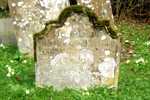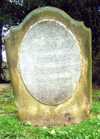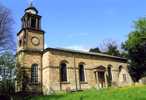For this church:    |
|
 West
wall of churchyard West
wall of churchyard |
 Entrance
gate to Entrance
gate tochurchyard |
The old churchyard slopes to the south west and in the spring is rich with snowdrops, daffodils, lesser celandine, primroses, forget-me-nots, and cowslips. There is a brick retaining wall running west from the church, forming the west boundary and then returning east for half the length of the old churchyard. The western wall has recently been restored. The churchyard is entered through a wrought iron gate and overthrow with lamp. The entrance is recognised as being of historic interest.
There are tombstones and headstones in the old churchyard which pre-date the present church, confirming that the new church is probably on the same site as the old. The earliest is of Barbara Binche who died in 1736. Many of the Denison family are buried in the vault, but in the churchyard there is the box tomb of John Denison (d. 15 May 1819). There is also a Denison plot in the churchyard, to the east of the path as it bends towards the door of the church, in which are buried William Evelyn Denison (d. 28 Sep 1916), George Charles Denison (29 March 1939), Lady Elinor Denison (29 July 1939), and the Rev Hon Percy Arthur Amherst (brother of Lady Elinor) (3 Feb 1910).
 The
oldest headstone The
oldest headstone |
 Grave
of John Grave
of JohnCharlesworth |
One Ossington incumbent is buried in the old churchyard: John Charlesworth (d.6 Dec 1821).
 The
sundial The
sundial |
The new churchyard given by Col. Max Denison, who inherited the estate from his aunt, Lady Elinor, and gave the old rose garden of the hall, lying to the east of the church, to be an extension of the churchyard. It partly occupies the site of the former mausoleum. This included the early sundial depicted in Thoroton’s engraving (1676) but placed in its present position in 1845.
Burial and interment of ashes continue to take place in this churchyard.
The earliest burial recorded in the current burial register is Elizabeth Ancliffe who died on 24 January 1813.






